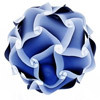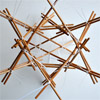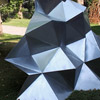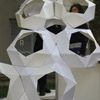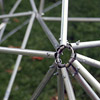This is the second year we are experimenting with a beautiful exercise with the Computation-based Basic Design 1 students at İstanbul Bilgi University Faculty of Architecture. The exercise is based on the ideas of Benay Gürsoy and Şebnem Yalınay, who are among the pioneers of this studio. The exercise is about the design and production of new year’s lanterns to be lit in the campus garden. Here are a few […]
Posts categorized under Basic Design
İstanbul Bilgi University Faculty of Architecture Basic Design II Spring 2012 undergraduate studio* group 6 includes both a geometric exploration and material research. They examined various formal alternatives, using wooden sticks and plastic tie-wrap connectors. After these experiments, they constructed a 1:1 material system spanning 4 meters in length and 2 meters in height, using 2.5km of wooden sticks and 18.000 tie wraps. This was an enormous effort to create […]
İstanbul Bilgi University Faculty of Architecture Basic Design II Spring 2012 undergraduate studio* group 8’s project is a metal surface construction. Group of first year design students were capable of designing, modeling, fabricating and assembling the structure with a good precision. After physical prototypes of the proposed spanning structure, they further experimented in rhinoceros and sent faces to plasma cutting and bending process. Finally, they assembled the faces with nails […]
Below is the final project of group 3 at İstanbul Bilgi University Faculty of Architecture Basic Design II Spring 2012 undergraduate studio*. First photo shows students’ efforts on generating formal variations. They studied much on this folding components and attaching them together to create surfaces. Their final surface spans nearly 2.5 meters in height. Forex is used as main material and they nailed them from faces. The different sizes, shapes […]
This is the final project of group 2 at İstanbul Bilgi University Faculty of Architecture Basic Design II Spring 2012 undergraduate studio*. 1:1 material system is constructed by two layers of tesselfations, triangular and hexagonal. They studied much for the connection detail and elaborated the structure to maintain stasis within a dynamic pose. They have used a Grasshopper definition (described here) to label and measure all of 800 rods into […]

